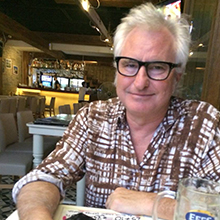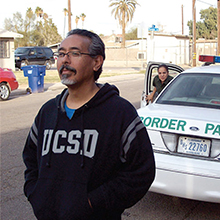TONG TANA
by secession

This work has been commented by 2 curator(s). Read the comments
Title
TONG TANA
Headline
a spoken word fusion
Concept author(s)
Andrew Garton
Concept author year(s) of birth
1962
Concept author(s) contribution
Writer, producer, composer, narrator.
Concept author(s) Country
Australia
Friendly Competition
Radical intimacies: dialogue in our times (2014)
Competition category
Mobilization
Competition field
nonacademic
Competition subfield
artist
Subfield description
I am a multidisciplinary artist working with sound, music, video, text and online media. I have a special interest in working within culturally diverse communities. My sound and music works are broadcast on radio both in Australia and Europe. Video works, from documentaries to projected video art, have been exhibited in various galleries and public spaces (e.g. ACMI, Federation Square, Signal, Casula Powerhouse). More recently I have been screening short films produced in collaboration with bush fire affected communities in church and community halls in fire affected shires.
Check out the Radical intimacies: dialogue in our times 2014 outlines of Memefest Friendly competition.
Description of idea
Describe your idea and concept of your work in relation to the festival outlines:
TONG TANA is an ethnographic sound work, originaly conceived of as an installation / performance, but completed as a documentary radio drama. It is comprised of field recordings, narrative and prose that describes both the plight of the remaining native forests of Sarawak, on the island of Borneo, and the cosmology of the first peoples who desire to still live in them. TONG TANA was performed in Cape Town in July 2009, developed through an artists residency at the Dunmoochin Foundation and broadcast in Austria in association with ORF/KunstRadio on 30 August 2014.
What kind of communication approach do you use?
Within TONG TANA I chose to use a combination of documentary style exposition and drama through the use of poetry. I have found the concept of documentary drama enables the artist to tell stories and share qualitative information with a degree of intimacy that may not be possible through other means. Both forms are underscored by field recordings and treated string instruments, specifically the Sapeh, a traditional instrument from Sarawak. The idea was to produce an evocative work for radio that sits within the genres of documentary and radio drama.
What are in your opinion concrete benefits to the society because of your communication?
I have found the combination of tender sound works and composition, in concert with documentary drama approaches enables the artist to tell stories and share qualitative information with a degree of intimacy that may not be possible through other means. The issues are described in a manner that attempts to draw people into a world of compassion and empathy; the idea being that we are all in this together. Whether TONG TANA benefits society remains to be seen. All I know is that when I am compelled to produce a work that synthesizes personal experience with a notion of the common good, I will do what ever it takes to bring it into the visible and / or heard world.
What did you personally learn from creating your submitted work?
I struggled through this project finding my self re-writing it almost entirely. The first script was written in 2009. The process gave me pause to reflect on what it is I truly wanted to communicate and how to go about doing it. I learnt to trust my intuition, to know that saying a thing directly, from ones heart, through extractive means (e.g. hard work) that overrides the obvious, drawing one to the sublime... Well, it really is about hard work and allowing oneself to literally walk ideas through until it is done, no matter the means nor time. In short I learnt to trust my processes, that I am experienced enough to do so, but to also be open to the notion that ones processes can do with a shake out every now and then. Perhaps more often than not. Particularly when seeking to reach deep into the core of one's audience.
Why is your work, GOOD communication WORK?
I believe it is GOOD communication WORK because it seeks empathy rather than judgement. It seeks to draw listeners into a world that they are a part of, not apart from. Personally if it reaches and moves a handful of people, no matter the number, the ripple effect of that reach can be far more far reaching than one can imagine.
Where and how do you intent do implement your work?
The radio version of TONG TANA was broadcast on 30 August in Europe. It is available for syndication to other broadcasters world-wide.
An accompanying video is being produced which would enable the work to be screened within an exhibition context and / or broadcast.
Did your intervention had an effect on other Media. If yes, describe the effect? (Has other media reported on it- how? Were you able to change other media with your work- how?)
Not that I am presently aware of. Not with TONG TANA specifically, however other works of mine have contributed to positive discourse around asylum seekers for example.
Curators Comments

Darren Tofts
This is an important ethnographic and poetic work that takes us into an intimate world that is arguably not very well known beyond itself. The aesthetic of working with sound to create an immersive world of interaction brings listeners (whoever they are and wherever they are from) into the fragile and beautiful world of the forests of Sarawak and its people, its animals and its land.
This work is especially intimate for as a soundspace it literally makes a somatic connection with the listener: and we know from Marshall McLuhan that sound is the most tactile medium and establishes an immediate connection. In this sense this work is a very intimate dialogue between people and place.
How do you see the proposed video working alongside the soundwork? It clearly is not necessary as a required "next stage" of the work, so what do you think vision has to offer the work and do you see this as enhancing its potential for intimacy with an audience?
Thank you for sharing such a beautiful work.

Ricardo Dominguez
The question of sonification and the un-documentary form is a always a difficulty endeavor-but the flavor of deep poetry and the space of poetic sustenance is always important to seek out. Especially in those conditions that communities escaping from one social condition and risk falling into another-in hope of something better continues to be extremely necessary to pursue by whatever means necessary.

9 years, 6 months ago
The accompanying video would be comprised of archival footage, mostly material shot in the mid-1950s, should I manage to source this material with the relevant permissions. It would provide a strong visual context to what has been lost against what remains. But I'm also glad to know that the work stands up entirely on its own given too that I'm often designing such works in an visual manner evocative to the ears.